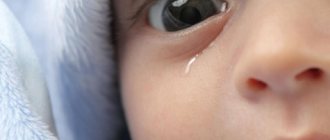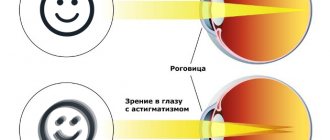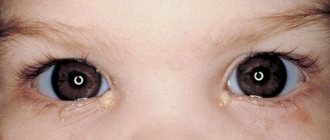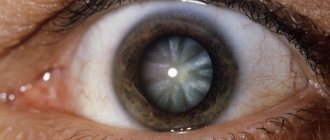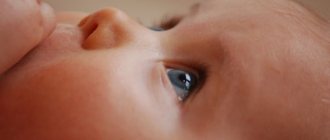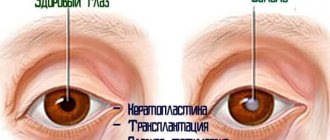Vision plays a vital role in the development of a child from the first days. The eyes, along with other sense organs, are one of the channels for the every second receipt of information about the world around us. Images of people, objects and the environment around the child are necessary for the process of mental formation. Accordingly, any visual impairment negatively affects the formation of reactions, prevents full contacts with loved ones, and inhibits the development of cognitive functions.
Most often, visual impairment in childhood is caused by genetic predisposition or infection during fetal development. In this case, the pathology is detected at birth. If blindness or partial loss of vision due to cataracts is diagnosed, there is still a chance for surgical treatment. And although surgery for congenital lens opacification in most cases does not lead to complete restoration of vision, significant improvement is still possible - therefore, as a rule, the ophthalmologist recommends microsurgical intervention. In early childhood, even partial restoration of vision in combination with adequate developmental techniques allows the child to fully develop.
The structure of the eye has a complex structure. The optical properties of its elements are such that incoming light rays are first refracted and then focused by the lens on the retina. Any disruption of these physical processes makes vision blurry. If the lens of the eye loses its transparency and elasticity, light rays are refracted at incorrect angles and/or focused in front of or behind the desired point. In this case (when the reason is precisely a change in the optical properties of the lens), cataract is diagnosed - a disease that does not develop back and is subject only to surgical treatment.
Congenital cataract
The causes of congenital cataracts are not entirely clear. Bilateral congenital cataracts are more often diagnosed, and the fact that both lenses are affected suggests the systemic nature of the reasons that caused the pathology. It has been noted that in 25% of cases of congenital cataracts, parents had a predisposition to this disease - therefore, a genetic factor is involved in the development of cataracts. In addition, the incidence of congenital lens opacities is higher in newborns who have had intrauterine infection. The statistical connection with influenza, rubella and toxoplasmosis suffered by mothers during pregnancy is especially significant. Risk factors are also considered:
- uncontrolled medications taken, self-medication during pregnancy;
- injuries to mother and fetus;
- Metabolic disorders, calcium deficiency.
Complete congenital cataracts are diagnosed without specific tests by the milky white color of the pupil. Clouding of the lens, which rapidly develops in the first three months after birth, is also considered congenital. The color of the pupil begins to change (lighten), it becomes clear that the baby only reacts to light, but does not distinguish objects.
Signs that should be a cause for concern in the first months of a child’s life:
- visible clouding on the pupil (light disk, dot);
- the child does not even briefly fix his gaze on objects;
- the baby does not follow the toy or the mother’s face with his eyes, and reacts only to sound stimuli;
- strabismus (asymmetrical arrangement of pupils);
- the tendency to always turn the same eye towards the object being examined.
Risk group
The risk group includes pregnant women who are forced to take steroids, sedatives and other drugs for a long time due to a corresponding health condition. Uncontrolled use of contraceptives, especially in the first weeks, when the woman is not yet aware of her situation. Bad habits and self-use of any medications (in particular, antibacterial agents) increase the risk of developing visual abnormalities.
Women with chronic pathologies (heart disease, thyroid disease, autoimmune pathologies) must be registered. Doctors must constantly monitor the health of the mother, the development of the fetus and the organization of a safe birth. Patients with cataracts are at risk. If the second parent is also susceptible to visual pathology, then the risk of developing lens clouding in a child from an early age increases several times.
Partial and punctate cataracts
Partial cataracts are quite rare, and their manifestations are not so obvious. For example, only a slight decrease in visual acuity may be observed. However, when the child enters school, i.e. As eye strain increases, the disease begins to have a noticeable negative impact on the quality of life. Cataracts in this form develop pointwise and have a number of symptoms:
- the focus of opacification on the lens looks like individual dots or scattered heterogeneous areas;
- The protein may not change in color or be slightly lighter;
- Vision is partially reduced and may be manifested by blurred images or visible darkening in the field of view.
It has been proven that the development of partial cataracts is, to one degree or another, associated with one of the following factors:
- chromosomal pathologies;
- prematurity;
- intrauterine infection;
- background systemic diseases (diabetes mellitus, calcium metabolism disorders, Wilson's disease, autosomal recessive syndrome, hypoglycemia).
Also, the formation of partial cataracts can be caused by the action of toxins. One of the mechanisms contributing to chemical damage to the eye is the formation of free radicals. The structure of the eye allows light rays to penetrate inside; this factor is decisive for the passage of chemical reactions with the formation of free radicals. A side effect of such processes is constant intoxication of the eye, especially with reduced immunity and metabolic disorders.
Varieties
Depending on the size of the opacification and the areas where it is located, the following types of cataracts are distinguished:
- capsular. The lens remains clear, but its posterior or anterior capsules become cloudy. If both capsules are damaged at the same time or one of them is significantly damaged, the baby goes blind. In other cases, doctors observe a slight decrease in visual acuity;
- polar. The lens is affected on all sides. In some cases, changes also affect the capsule, but this is not diagnosed in all children. The degree of vision loss depends on the individual case;
- layered. The lens is damaged bilaterally, visual acuity is low. Affects one or more layers of the lens. This is the most common form of cataract in newborns;
- nuclear cataract. In this case, the nucleus, the central part of the lens, is affected. Develops due to genetic reasons. A child with this form of the disease is practically unable to see;
- complete. The clouding affects the entire lens, and the baby becomes blind.
Treatment of childhood cataracts
Cataracts in children, as in any other age categories, can only be treated surgically, however, in pediatric ophthalmic surgery this process has some peculiarities. When a newborn is completely blind, first of all, an accurate and reliable diagnosis is necessary, confirming that the cause is cataracts and not other congenital pathologies.
It is recommended to perform surgery for congenital cataracts between the ages of one and two years. Surgery at an earlier age is undesirable, however, you should not delay treatment. It is known that in the first months and years a person receives up to 95% of the total amount of information about the world around him that he will accumulate throughout his life. It is obvious that blindness irreparably impoverishes the process of cognition and deprives the child of full development; Delayed restoration of vision for too long will have time to negatively affect the formation of cognitive functions and the development of the baby’s psyche. Therefore, in children operated on at 3 or 4 years of age, there is some developmental delay, which requires the use of special training programs.
If the congenital cataract is bilateral, then surgical treatment is performed in two stages, but the interval between implantation of artificial lenses (first in one eye, then in the other eye) should not exceed three months, otherwise uneven vision restoration is possible.
After surgery, the child should be regularly monitored by an ophthalmologist for two years.
Symptoms
The manifestation of the disease in a child is influenced by the degree of clouding of the lens, damage to one or both eyes, and the location of the clouding focus.
Even in the maternity hospital, doctors will be able to determine the presence of the disease in a newborn.
At the age of one month, ophthalmologists check the child’s vision during a preventive examination.
Childhood cataracts can be visually recognized if:
- one or both pupils of the child have become white or gray;
- the child is not able to focus, for example, on a toy, he inactively watches moving objects and people;
- The child's eye movements become uncontrollable.
Manifestation of cataracts in a child's eye.
To enlarge, click on the image. The first warning sign that a child is developing cataracts may be a change in behavior. For example, a child looks at rattles with just one eye. Schoolchildren begin to study worse, it becomes more difficult for them to focus their eyes and concentrate. Parents who notice such changes should take them seriously and immediately bring their child to be examined by an ophthalmologist.
Note that such symptoms may indicate that the child has other eye diseases. In any case, only a specialist will be able to correctly diagnose the disease and prescribe the necessary treatment.
Prevention of congenital and acquired cataracts
To reduce the risk of developing congenital cataracts, it is necessary to exclude harmful influences, stress and infections during pregnancy. If there is information about a hereditary predisposition to the disease, the pregnancy is carried out taking this into account, and the vision of the newborn is examined immediately after birth.
To reduce the likelihood of cataracts occurring throughout your life, you need to protect your eyes from prolonged exposure to sunlight, avoid exposure to radiation and intoxication, including direct contact of harmful substances with your eyes. Needless to say, it is necessary to be attentive to any changes in visual acuity, regularly undergo preventive examinations by an ophthalmologist, and also promptly seek medical help for injuries and infectious diseases of the eyes.
Diagnostic methods
For the first time, cataracts in a fetus can be detected using ultrasound screening in the 2nd trimester of pregnancy: normally, the lens will appear as a dark spot on the screen.
Immediately after birth, the newborn should be examined by a pediatrician, who may notice slight clouding of the transparent body in the center, impaired passage of light rays, strabismus, or nystagmus.
To make a diagnosis use:
- ophthalmoscopy;
- biomicroscopy of the eye using a slit apparatus;
- Ultrasound examination of the eyeball.
These instrumental diagnostic methods will help identify changes in the transparency of the lens, as well as exclude other abnormalities, in particular retinopathy and tumors.
Postoperative period
After the patient's eyes have been operated on and the lens has been removed, the doctor will prescribe contact lenses or glasses if both eyes were affected, since the eyes cannot focus on their own.
Also, glasses or lenses are prescribed to children when they were given artificial lenses during surgery. After all, they work like with farsightedness - they focus well on distant objects, but close ones will be blurred.
Typically, an ophthalmologist does not prescribe lenses or glasses immediately, but rather some time after surgery. The doctor must explain the rules for caring for lenses and the frequency of changing them.
If your child has had surgery on one eye, the doctor may prescribe wearing a patch on the good eye. You don't need to wear it for long until the operated eye starts working. If previously a diseased eye might not transmit signals from what it saw to the brain, then after wearing such a blindfold the eye will work as expected. The baby needs parental support, the process is not very pleasant.
Please note that after the operation, the child must periodically come to the ophthalmologist for examination.
Traditional methods
Sometimes, to treat cataracts, they resort to the achievements of alternative medicine:
- Dill seeds. Take 3 teaspoons of dill seeds, place them in 2 fabric bags (it should hold water well) measuring five by five centimeters. Pour water into the bags with seeds and boil. Then cool them and apply to your eyes. Keep the compress for 15 minutes.
- Calendula. Take 2 teaspoons of calendula officinalis flowers and pour 2 cups of boiling water. The resulting infusion can be used internally and can also be used to wash the eyes.
- Parsley and carrot juices. You need to combine them in a ratio of one to ten, mix well. Drink 3 times a day.
- Spinach and carrot juices. Combine in a ratio of one to five. Drink 3 times a day.

